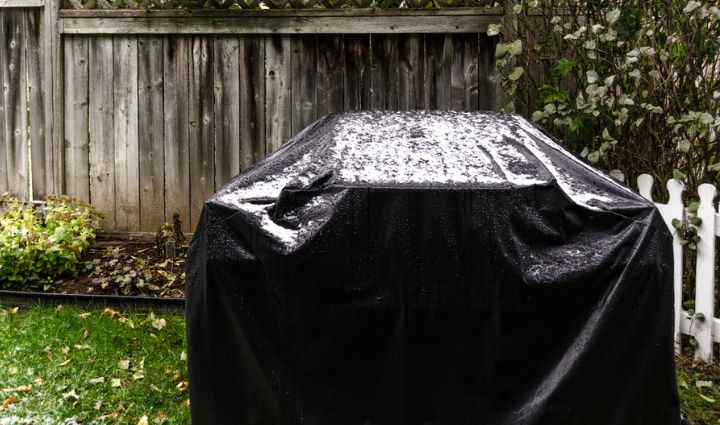One of the biggest mistakes you can make when you grill is to leave your barbecue unprotected and exposed to the elements. If you want your barbecue to last for years to come, a high-quality weather-resistant grill cover is key. “But what size grill cover do I need?” you ask. We’ll tell you.
Even if your patio or deck is sheltered by an awning or other structure, covering your grill is still very important to protect it from certain weather conditions, like rain and snow. A good quality grill cover will also protect your barbecue against the sun’s harsh rays, falling leaves, bird bombs, particulates, and other potentially damaging debris.
A grill cover should fit your grill in order to be as effective as possible. Not sure what size grill cover you need? We’ve got you “covered”.
There are several ways to determine which cover is best for your grill. In this post, you’ll find:
- How to measure for a grill cover
- Grill cover features to look for
- Grill cover size charts for popular brands so you can find the right cover for your barbecue
- When to cover a grill
- When you can leave your barbecue uncovered
Let’s dig in.
How to Measure For a Grill Cover
Whether it’s a universal fit or model-specific grill cover, you’ll find that most barbecue covers are sized to fit three dimensions: width, height, and depth. Begin by measuring the following:
- The width of your BBQ including the side shelves and side burner unit. This is the most important measurement as many grill covers are sold based on their width—for example, a “60-inch heavy-duty cover”. One caveat to this is for a compact or small-spaces gas grill where the side shelves fold down. In this case, the grill cover width measurement typically assumes that the side shelves are folded down.
- The height from the top of the casters or wheels (or ground) all the way to the top of the lid when closed.
- The depth from the back of the lid to the front of the lid handle or control panel—whichever sticks out the furthest.
Now that you know the size of your grill, you should look for a cover that measures at least a couple of inches larger than your measurements to make it as easy as possible to turn the cover on or take it off.
Grill Cover Features
When it comes to protecting your grill with a cover, there are several features you’ll want to look for:
- Air vents: To allow for airflow, which helps to release excess moisture that would otherwise be trapped under the cover
- Handles: To make uncovering and covering much easier
- Buckles, velcro straps, or a drawcord hem: To help secure the cover to the grill
Finally, choose a strong material like PVC polyester rather than low-quality vinyl, which won’t hold up as well in harsh environments. PVC polyester is water and UV-resistant and tends not to crack or peel in extreme temperatures. Look for polyester covers with a minimum of 400D x 400D or higher. “D” refers to “denier” which is a measure of the thickness of the fibers used in the fabric. Higher denier fabric produces a weightier and more durable cover.
GRILL SPOT TIP: Stay away from grill covers made with felt—animals are attracted to felt; they like to tear it up and use it to build nests.
Grill Cover Size Chart
We’ve created grill cover size charts for our universal fit grill covers. As long as you purchase the right size, our universal fit covers will work for all of the most popular brands, including Weber, Napoleon, and more.
When to Cover a Grill
You may not need to cover your grill 24/7, but there are certain times you’ll definitely want to keep it protected:
- In the rain: Cover your grill when it rains to prevent rust and corrosion.
- In the winter: Covering your grill in the winter keeps snow/moisture off the grill, but also makes it a heck of a lot easier to use the grill too. The combination of snow and sun can completely ice up your grill, but covering it prevents this from happening. Plus, pushing the snow off the cover is a lot easier than digging the grill out from under a pile of snow and ice.
- In an uncovered area: If your grill is left exposed (not under an awning or other structure), you should use a cover to protect it from debris, such as leaves, bird droppings, and particulates. Over time an uncovered grill will start to look dull, dusty, and tired.
When to Leave a Grill Uncovered
While we generally recommend covering your grill to keep it looking and functioning at its best for years to come, sometimes it’s best to leave your BBQ uncovered, such as:
- When it’s hot: Most grill covers are not flame or heat-retardant, so make sure you let your grill cool down fully before covering it.
- In high humidity: Certain climates and times of year are extremely humid (e.g. Florida or Louisiana), and covering your grill may actually trap moisture, causing it to rust or erode.
- In dry climates: If you live in an area with a very dry climate (like Texas, Arizona, or Nevada ), it’s safe to leave your grill uncovered periodically, but we do recommend using a cover most of the time to keep out dust, and debris.
Wrapping Up
From portable to premium, and from gas to charcoal, GrillSpot has a grill cover to fit your BBQ. Shop our extensive selection of grill covers online now.








